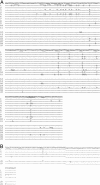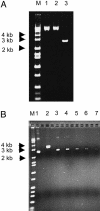Activation-induced cytidine deaminase (AID) can target both DNA strands when the DNA is supercoiled
- PMID: 15328407
- PMCID: PMC516507
- DOI: 10.1073/pnas.0404974101
Activation-induced cytidine deaminase (AID) can target both DNA strands when the DNA is supercoiled
Abstract
The activation-induced cytidine deaminase (AID) is required for somatic hypermutation (SHM) and class-switch recombination of Ig genes. It has been shown that in vitro, AID protein deaminates C in single-stranded DNA or the coding-strand DNA that is being transcribed but not in double-stranded DNA. However, in vivo, both DNA strands are mutated equally during SHM. We show that AID efficiently deaminates C on both DNA strands of a supercoiled plasmid, acting preferentially on SHM hotspot motifs. However, this DNA is not targeted by AID when it is relaxed after treatment with topoisomerase I, and thus, supercoiling plays a crucial role for AID targeting to this DNA. Most of the mutations are in negatively supercoiled regions, suggesting a mechanism of AID targeting in vivo. During transcription the DNA sequences upstream of the elongating RNA polymerase are negatively supercoiled, and this transient change in DNA topology may allow AID to access both DNA strands.
Copyright 2004 The National Academy of Sciencs of the USA
Figures




Similar articles
-
Targeting of the activation-induced cytosine deaminase is strongly influenced by the sequence and structure of the targeted DNA.Mol Cell Biol. 2005 Dec;25(24):10815-21. doi: 10.1128/MCB.25.24.10815-10821.2005. Mol Cell Biol. 2005. PMID: 16314506 Free PMC article.
-
Activation-induced cytidine deaminase acts on double-strand breaks in vitro.Mol Immunol. 2007 Feb;44(5):974-83. doi: 10.1016/j.molimm.2006.03.015. Epub 2006 May 11. Mol Immunol. 2007. PMID: 16697045
-
Deoxyuridine is generated preferentially in the nontranscribed strand of DNA from cells expressing activation-induced cytidine deaminase.J Immunol. 2005 Jun 15;174(12):7787-91. doi: 10.4049/jimmunol.174.12.7787. J Immunol. 2005. PMID: 15944282
-
Activation-induced cytidine deaminase: structure-function relationship as based on the study of mutants.Hum Mutat. 2006 Dec;27(12):1185-91. doi: 10.1002/humu.20414. Hum Mutat. 2006. PMID: 16964591 Review.
-
Complex regulation and function of activation-induced cytidine deaminase.Trends Immunol. 2011 May;32(5):194-201. doi: 10.1016/j.it.2011.03.003. Epub 2011 Apr 13. Trends Immunol. 2011. PMID: 21493144 Free PMC article. Review.
Cited by
-
Regulation of immunoglobulin class-switch recombination: choreography of noncoding transcription, targeted DNA deamination, and long-range DNA repair.Adv Immunol. 2014;122:1-57. doi: 10.1016/B978-0-12-800267-4.00001-8. Adv Immunol. 2014. PMID: 24507154 Free PMC article. Review.
-
Mutating for Good: DNA Damage Responses During Somatic Hypermutation.Front Immunol. 2019 Mar 12;10:438. doi: 10.3389/fimmu.2019.00438. eCollection 2019. Front Immunol. 2019. PMID: 30915081 Free PMC article. Review.
-
AID and Apobec3G haphazard deamination and mutational diversity.Cell Mol Life Sci. 2013 Sep;70(17):3089-108. doi: 10.1007/s00018-012-1212-1. Epub 2012 Nov 22. Cell Mol Life Sci. 2013. PMID: 23178850 Free PMC article. Review.
-
Sense transcription through the S region is essential for immunoglobulin class switch recombination.EMBO J. 2011 Apr 20;30(8):1608-20. doi: 10.1038/emboj.2011.56. Epub 2011 Mar 4. EMBO J. 2011. PMID: 21378751 Free PMC article.
-
The cytidine deaminases AID and APOBEC-1 exhibit distinct functional properties in a novel yeast selectable system.Mol Immunol. 2006 Feb;43(4):295-307. doi: 10.1016/j.molimm.2005.05.004. Epub 2005 Jun 15. Mol Immunol. 2006. PMID: 15963568 Free PMC article.
References
-
- Muramatsu, M., Sankaranand, V., Anant, S., Sugai, M., Kinoshita, K., Davidson, N. & Honjo, T. (1999) J. Biol. Chem. 274, 18470–18476. - PubMed
-
- Muramatsu, M., Kinoshita, K., Fagarasan, S., Yamada, S., Shinkai, Y. & Honjo, T. (2000) Cell 102, 553–563. - PubMed
-
- Revy, P., Muto, T., Levy, Y., Geissman, F., Plebani, A., Sanal, O., Catalan, N., Forveille, M., Dufourcq-Lagelouse, R., Gennery, A., et al. (2000) Cell 102, 565–575. - PubMed
-
- Diaz, M. & Storb, U. (2003) DNA Repair 2, 623–627. - PubMed
Publication types
MeSH terms
Substances
Grants and funding
LinkOut - more resources
Full Text Sources
Other Literature Sources

